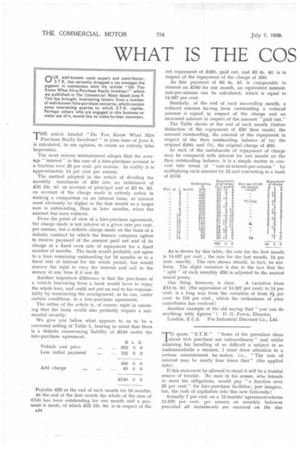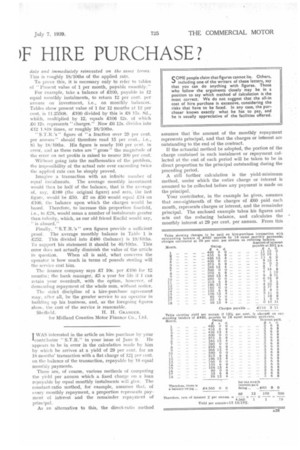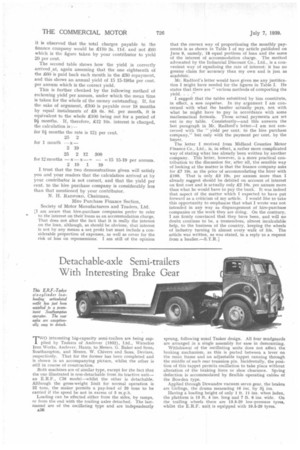WHAT IS THE COS
Page 52

Page 53

Page 54

If you've noticed an error in this article please click here to report it so we can fix it.
,F HIRE PURCHASE?
THE article headed "Do You Know What Hire Purchase Really Involves? " in your issue of June 9, is calculated, in our opinion, to create an entirely false impression.
The most serious misstatement alleges that the average " interest " in the case of a hire-purchase account is a fraction over 29 per cent. per annum. In reality it is approximately 14 per cent per annum.
The method adopted in the article of dividing the monthly instalment of £30 into an instalment of £26 13s. 4d. on account of principal and of £3 6s. 8d. on account of the charge made is entirely unfair in making a comparison on an interest basis, as interest must obviously he higher in the first month as a larger sum is outstanding, than in later months, when the amount has been reduced.
From the point of view of a hire-purchase agreement, the charge made is not interest at a given rate per cent. per annum, but a definite charge made on the basis of a definite contract by which the finance company agrees to receive payment of the amount paid out and of its charge at a fixed even rate of repayment for a fixed number of months. The bank would probably not agree to a loan remaining outstanding for 18 months or to a fixed rate of interest for the whole period, but would reserve the right to vary the interest and call in the money at any time if it saw fit.
Another important difference is that the purchaser of a vehicle borrowing from a bank would have to repay the whole loan, and could not put an end to his responsibility by terminating the arrangement, as he can, under certain conditions, in a hire-purchase agreement.
The writer of the article is, of course, right in assuming that the bank would also probably require a substantial security.
We give you below what appears to us to he a corrected setting of Table 1, bearing in mind that there is a definite commencing liability of £540 under the hire-purchase agreement.
Payable £30 at the end of each month for 18 months. At the end of the first month the whole of the sum of
£540 has been outstanding for one month and a pay ment is made, of which £23 13s. 8d. is in respect of the .a34
net repayment of £480, paid out, and £6 6s. 44. is in respect of the repayment of the charge of £60.
As this payment of £6 GS. 44. is comparable to interest on £540 for one month, an equivalent interestrate-per-annum can be calculated, which is equal to 14.037 per cent.
Similarly, at the end of each succeeding month, a reduced amount having been outstanding a reduced amount is repaid in respect of the charge and an increased aniount in respect of the amount "paid out."
The Table shows at the end of each month (before deduction of the repayment of £30 then made) the amount outstanding, the amount of the repayment in respect of the then outstanding balance of (a) the original £480, and (b), the original charge of MO.
As each of the instalments of repayment of charge may be compared with interest for one month on the then outstanding balance, it is a simple matter to convert into terms of " rate-of-interest-per-annum " by multiplying each amount by 12 and converting to a basis of £100.
As is shown by this table, the rate for the first month is 14.037 per cent. ; the rate for the last month, 14 per cent. exactly. The rate shown should, in fact, be uniform. The slight variation is due to the fact that the " split " of each monthly £30 is adjusted to the nearest round penny.
One thing, however, is clear. A variation from £14 Os. 9d. (the equivalent of 14.037 per cent) to 14 per cent, is a long way from the variation of from Si per cent. to 150 per cent., which the enthusiasm of your contributor has evolved!
Another example of the old saying that "you can do anything with figures " I H. G. FOXE, Director, London, E.C.3. For Industrial Discount Co., Ltd.
quote " S.T.R." "Some of the prevalent ideas about hire purchase are extraordinary" and whilst admiring his handling of so difficult a subject in so understandable a manner, I must draw attention to a serious misstatement he makes, i.e., "The rate of interest may be nearly four times that" (the applied rate).
If this statement be allowed to stand it will be a fruitful source of trouble. No man in his senses, who intends to meet his obligations, would pay "a fraction over 29 per cent." for hire-purchase facilities; just imagine, too, the rush of capitalists into this new Golconda!
Actually 7 per cent. on a 12 months' agreement returns 12.676 per cent, per annum on monthly balances provided all instalments are received on the due
date and immediately reinvested on the same terms. This is roughly 18/10ths of the applied rate.
To prove this, it is necessary only tà refer to tables of " Present value of 1 per month, payable monthly."
For example, take a balance of £100, payable in 12 equal monthly instalments, to return 12 per cent, per annum on investment, i.e., on monthly balances. Tables show present value of 1 for 12 months at 12 per cent. is 11.25508. £100 divided by this is £8 17s. 8d., whiCh, multiplied by • 12, equals 2106 12s. of which £0 12s. represents "charges." Now 2(1 12s. divides into 212 1.818 times, or roughly 18/10ths.
S.T.R.'s " figure of "a fraction over 29 per cent. per annum" should therefore read 15 per cent., i.e., 81 by 18/10ths. His figure is nearly 100 per cent, in error, and as these rates are " gross " the magnitude of the error on net profits is raised to nearer 300 per cent
Without going into the mathematics of the problem, the impossibility of the actual rate ever exceeding twice the applied rate can be simply proved.
Imagine a transaction with an infinite number of equal instalments. The average monthly investment would then be half of the balance, that is the average of, say, 2100 (the original figure) and zero, the last figure, would be 250. £7 on £50 would equal 214 on 2100, the balance upon which the charges would be based, Therefore, to increase this proportion fourfold, i.e., to 228, would mean a number of instalments greater than infinity, which, as our old friend Euclid would say, " is absurd."
" S.T.R.'s" own figures provide a sufficient proof. The average monthly balance in Table 1 is 2252. This divided into 2480 (balance) is 19/10ths. To support his staternent it should be 40/10ths. This error does not actually diminish the value of the article in question. When all is said, what concerns the operator is how much in terms of pounds sterling will the service cost him.
The finance company says 27 10s. per 2100 for 12 months; the bank manager, £5 a year for life if I can retain your overdraft, with the option, however, of demanding repayment of the whole sum, without notice.
The strict discipline of a hire-purchase agreement may, after all, be the greater service to an operator in building up his business, and, as the foregoing figures show, the cost of the service is reasonable.
Sheffield. H. H. GRANGER, for Midland Counties Motor Finance Co., Ltd.
T WAS interested in the article on hire purchase by your 'contributor " S.T.R." in your issue of June 9. He appears to be in error in the calculation made by him by which he arrives at a yield of 29 per cent, for an 18 months' transaction with a flat charge of 121 per cent, on the balance of the transaction, repayable by 18 equal monthly payments.
There are, of course, various methods of computing the yield per annum which a fixed charge on a loan repayable by equal monthly instalments will give. The constant-ratio method, for example, assumes that, of every monthly repayment, a proportion represents payment of interest and the remainder repayment of principal.
As an alternative to this, the direct-ratio method
assumes that the amount of the monthly repayment represents principal, and that the charges or interest are outstanding to the end of the contract.
If the actuarial method be adopted, the portion of the charge contained in each instalment or repayment collected at the end of each period will be taken to be in direct proportion to the principal outstanding during the preceding period.
A still further calculation is the yield-minimum method, under which the entire charge or interest is assumed to be collected before any payment is made on the principal. Your contributor, in the example he gives, assumes that one-eighteenth of the charges of £60 paid each month, represents charges or interest, and the remainder principal. The enclosed example takes his figures and sets out the reducing balance, and calculates the monthly interest at 29 per cent, per annum. From this it is observed that the total charges payable to the finance company would be £110 3s. 11d, and not £60 which is the figure taken by your contributor to yield 29 per cent.
The second table shows how the yield is correctly arrived ,at, again assuming that the one eighteenth of the £60 is paid back each month in the £30 repayment, and this shows an annual yield of 15 15-19ths per cent, per annum which is the correct yield.
This is further checked by the following method of reckoning yield per annum, under which the mean time is taken for the whole of the money outstanding. If, for the sake of argument, £100 is payable over 18 months by equal instalments of £8 68. 8d. per month, it is equivalent to the whole £100 being out for a period of Elf months. If, therefore, £12 10s. interest is charged, the calculation is :
I trust that the two demonstrations given will satisfy you and your readers that the calculation arrived at by your contributor is not correct, and that the yield per cent. to the hire purchase company is considerably less than that mentioned by your contributor.
N. H. RADFORD, Chairman, Hire Purchase Finance Section, Society of Motor Manufacturers and Traders, Ltd. [I am aware that hire-purchase companies prefer to refer to the interest on their loans as an accommodation charge. That does not alter the fact that it is really the interest on the loan, although, as should be obvious, that interest is not by any means a net profit but must include a considerable proportion of expenses, as well as cover for the risk of loss on repossessions. I am still of the opinion that the correct way of proportioning the monthly payments is as shown in Table I of my article published on June 9, namely, 18 equal portions of loan and the same of the interest of accommodation charge. The method advocated by the Industrial Discount Co.. Ltd., is a convenient way of equalizing the rate of interest: it has no greater claim for accuracy than my own and is just as acadeinic.
Mr. Radford's letter would have given me any justification I might have needed for the figures in Table I. He states that there are " various methods of comporting the yield. . . ."
I suggest that the tables submitted by him constitute, in effect, a non sequitur. In my argument I am concerned with what the haulier actually pays, not with what he might have to pay in accordance with some mathematical formula. Those actual payments are set out in my table. Consistently—and this answers the last paragraph in Mr. Radford's letter—I am not concerned with the " yield per cent, to the hire purchase company," but only with the payment per cent, by the buyer.
The letter I received from Midland Counties Motor Finance Co., Ltd., is, in effect, a rather more complicated way of stating what has already been written by another company. This letter, however, is a more practical contribution to the discussion for, after all, the sensible way of looking at the matter is that the finance company asks for £7 10s. as the price of accommodating the hirer with £100. That is only £3 10s. per annum more than I already suggest should be debited on account of interest on first cost and is actually only £2 10s. per annum more than what he would have to pay the bank, It was indeed that aspect Of the matter which I expected to have put forward as a criticism of my article. I would like to take this opportunity to emphasize that what I wrote was not intended in any way as disparagement of hire-purchase companies or the work they are doing. On the contrary. I am firmly convinced that they have been, and Will no doubt continue to be, a tremendous, almost incalculable help, to the business of the country, keeping the wheels of industry turning in almost every walk of life. The article was written, as was stated, in a reply to a request from a haulier.—S.T.R.]




















































































